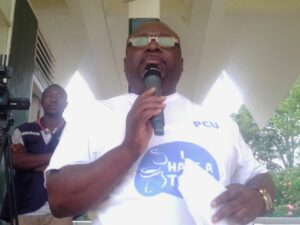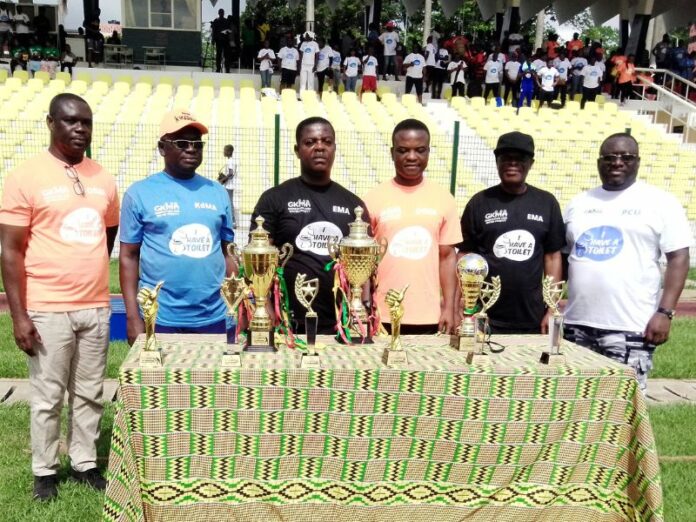The eight Metropolitan and Municipal Assemblies (MMAs) involved in the Greater Kumasi Household Toilet programme have been urged to double up their efforts to achieve the target of providing for 30,000 households.
The MMAs have also been implored to forge ahead to accomplish the task, which is in connection with achieving the United Nation’s Sustainable Development Goal 6 (SDG 6) – universal access to improved water and toilet facilities.
The Programme has provided 7,086 toilets to households, representing 52% of the total work.

If this development is anything to go by, the GKMA could be making significant progress in achieving Goal Six.
Dubbed Greater Kumasi Metropolitan Area Sanitation and Water Project (GKMA SWP), the project is an extension of the Greater Accra Sanitation and Water Project (GAMA SWP), which was started in 2015 .
After a successful project implementation at the end of 2020, the Ministry of Sanitation and Water Resources, with financing and technical support from the World Bank, agreed to extend the project to Greater Kumasi until the end of 2024.
The GKMA SWP is being implemented by the Metropolitan and Municipal assemblies, which constitute the Greater Kumasi Metropolitan Area, Asokore Mampong, Asokwa, Ejisu, KMA, Kwadaso, Oforikrom, Old Tafo, and Suame.
The project focuses on promotion/provision 30,000 household toilets and 120 institutional toilets, as well as the extension of piped water to households with the focus on low-income urban communities, and rehabilitation and expansion of the Asafo Sewerage System.
About sixteen months into the programme, Ejisu Municipal is leading the chart with a total of 1,533 toilets, representing 90% of the monthly target, followed by Kwadaso recording 949 toilet facilities, making 56%, and Suame constructing 587 toilets, which is 54%, as the other municipalities operate below 40%-50% of their targets.
The project is supposed to build an average of 850 toilets every month, but, as at now, most of the MMAs are unable to achieve their targets, providing about 450 toilets a month.
Addressing the media at a GKMA Household Toilet Jamboree, which was held at Paa Joe recently, where the eight MMAs were engaged in a competition to whip up their enthusiasm, Ing. Goerge Asiedu, Project Coordinator, disclosed that, so far, 7,086 toilets had been built against the target of 13,600, making the programme 52% complete, with a deficit of 6,500, representing 48%.
Ing. Asiedu stated that if they were to meet their target for the three years implementation, every year they should be able to do 10,000.
In this regard, he disclosed to the media that the purpose of the event was that of being a team building exercises to assist the eight MMAs achieve their targets.
According to Ing. Asiedu, they were seeking to instill in each assembly a level of renewed energy to be able to up their game towards achieving this noble objective of 30,000 toilets for the beneficiaries.
He said: “We are competing among ourselves, and by so doing, we are tasking and challenging ourselves with commitment and strategies to achieve the goal of providing 30,000 households toilet facilities.”
This feat, he indicated, could be achieved if they energise the MMAs with team building.
“We need to step up our game to be able to match up and achieve the target. The focus is to increase the number of assembly teams, with about 50 people representing here.” He stated “Initially, they were about fifteen in each of the assembly teams, so now we have about 50 people representing the assembly. We will give some rewards to them, hoping that at the end of the project any assembly that is able to achieve the target would be rewarded.”
On how to deepen the level of efficiency and effectiveness at the assembly level, Ing. Asiedu said that they were getting the environmental health officers ready for the work [for] which they were employed, and get the assemblies committed to their municipal function.
“Each of the assemblies has been able to come out with a plan to be able to achieve its target, and we will observe them as they go. We will also support them with logistics to enable [them] achieve their targets.”
On his part, Mr. John Yaw Donkor, Ashanti Regional Environmental Director, described the initiative of constructing 30,000 household toilet facilities as encouraging.
However, he added that there were some minor bottlenecks which ought to be addressed.
According to him, the demand was high for some categories of people, adding that space and multiple households had challenges in certain communities for the construction of the toilets; challenges, he noted, ought to be handled with care.
Yaw Donkor noted that by consensus, the communities were in love with the idea, since going to the public toilet came with discomforts.
Quizzed on the situation of open defecation in the region, the Ashanti Regional Environmental Director stated that project would bring about a drastic reduction in the practice.
He subsequently urged the public to embrace the programme, since it was an opportunity to own a toilet facility.
“If you are to own a toilet, you are likely to spend far more than what is on…, so we take the opportunity to appeal to the entire community members to take advantage of this opportunity to have a toilet, and it is going to help the nation as well.”
Mr. Ernest Bodoung, Ejisu Municipal Environmental Health Officer, in an interview with the media, disclosed that currently, Ejisu had registered 2,150 households for the toilet project -which have been paid fully.
According to Bodoung, they had also constructed 1,530 toilets, and handed them over to the beneficiaries, adding that the Assembly had intensified the house to house education, coupled with media attention.
This, according to him, was aimed at reducing open defecation to its barest minimum to curb environmental health related disease like Cholera which would also be come down.
He said: “If you look at Ashanti Region, open defecation is about 15%, so we were so happy when the World Bank and Ghana Government decided to bring it to [the] Ashanti Region so that we will be able to reduce open defecation.”
Quizzed about the target for Ejisu, Ernest Bodoung said that Ejisu had a target of 5,000 by close of 2023, and that they had already constructed over 1,500.
He disclosed that about five landlords were prosecuted by a court to go and construct a toilet each for their houses, but the judge decided to suspend the fine and directed the landlords to use two months to construct the toilets.










